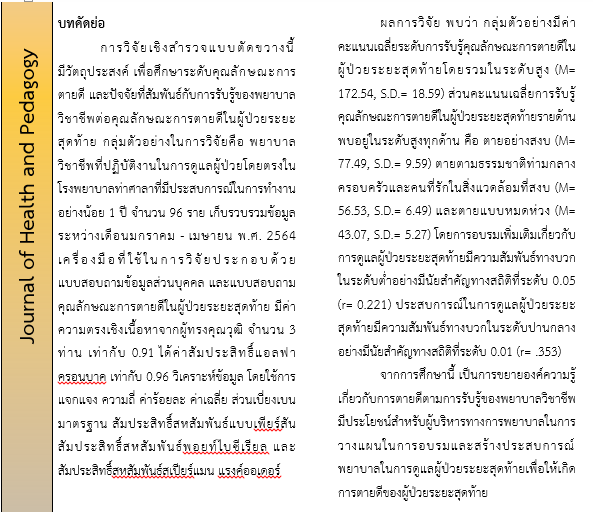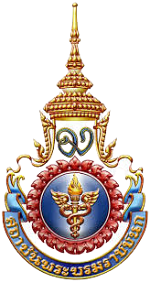ปัจจัยที่สัมพันธ์กับคุณลักษณะการตายดีในผู้ป่วยระยะสุดท้ายตามการรับรู้ ของพยาบาลวิชาชีพ โรงพยาบาลท่าศาลา จังหวัดนครศรีธรรมราช
คำสำคัญ:
คุณลักษณะการตายดี, ผู้ป่วยระยะสุดท้าย, พยาบาลวิชาชีพบทคัดย่อ
การวิจัยนี้เป็นการวิจัยเชิงสำรวจแบบตัดขวาง มีวัตถุประสงค์เพื่อศึกษาปัจจัยที่เกี่ยวข้องกับการตีตรา
ทางสังคมต่อผู้ติดเชื้อโควิด-19 ของประชาชนในอำเภอท่าศาลา จังหวัดนครศรีธรรมราช ประชากรที่ใช้ศึกษา คือประชาชนที่มีอายุ 18 ปีขึ้นไป ที่อาศัยอยู่ในอำเภอท่าศาลา จำนวน 303 ราย เก็บข้อมูลระหว่างเดือนสิงหาคม พ.ศ. 2563 ถึงเดือนมกราคม พ.ศ. 2564 เครื่องมือที่ใช้เป็นแบบสอบถาม ซึ่งมีค่าความเชื่อมั่นของแบบสอบถามทั้งฉบับเท่ากับ 0.91 วิเคราะห์ข้อมูลโดยใช้การแจกแจงความถี่ ร้อยละ ค่าเฉลี่ย ส่วนเบี่ยงเบนมาตรฐาน สัมประสิทธิ์สหสัมพันธ์แบบเพียร์สัน สัมประสิทธิ์สหสัมพันธ์พอยท์ไบซีเรียล สัมประสิทธิ์สหสัมพันธ์สเปียร์แมน แรงค์ออเดอร์ และการวิเคราะห์ความถดถอยเชิงพหุ
ผลการวิจัยพบว่า กลุ่มตัวอย่างมีค่าคะแนนเฉลี่ยระดับความรู้เกี่ยวกับโรคโควิด-19 และชีวิตวิถีใหม่
ด้านการป้องกันโรคโควิด-19 ระดับสูงมาก คะแนนเฉลี่ยความกลัวโรคโควิด-19 และการตีตราทางสังคมต่อผู้ติดเชื้อโควิด-19 ในระดับสูง ความกลัวการติดเชื้อโควิด-19 มีความสัมพันธ์ทางบวกในระดับปานกลางกับการตีตราทางสังคมต่อผู้ติดเชื้อโควิด-19 อย่างมีนัยสำคัญทางสถิติ (r= 0.617) ส่วนความรู้เกี่ยวกับการติดเชื้อโควิด-19 การศึกษามีความสัมพันธ์ทางลบในระดับต่ำกับการตีตราทางสังคมต่อผู้ติดเชื้อโควิด-19 อย่างมีนัยสำคัญทางสถิติ (r= -0.265 และ rsp= -0.174) ความกลัวการติดเชื้อโควิด-19 และความรู้เกี่ยวกับการติดเชื้อโควิด-19 สามารถร่วมทำนายการตีตราทางสังคมต่อผู้ติดเชื้อโควิด-19 ได้ร้อยละ 38.6 อย่างมีนัยสำคัญทางสถิติ
ดังนั้น บุคลากรด้านสุขภาพสามารถนำผลการศึกษาไปใช้เพื่อพัฒนาโปรแกรมการให้ความรู้ และ
ลดความกลัวการติดเชื้อโควิด 19 ของประชาชน เพื่อป้องกันการตีตราทางสังคมต่อผู้ติดเชื้อโควิด-19 ให้สามารถใช้ชีวิตอยู่ในสังคมอย่างปกติสุข
เอกสารอ้างอิง
Abdelhafiz, A. S. & Alorabi, M. (2020). Social stigma: the hidden threat of COVID-19. Frontiers in Public Health, 8, 1-4.
Ahmad T. H., Baig, M., & Hui, J. (2020). Coronavirus disease 2019 (COVID-19) pandemic and economic impact. Pakistan Journal Medical Sciences, 36(COVID19-S4), S1-S6.
Ahorsu, D. K., Lin, C. Y., Imani, V., Saffari, M., Griffiths, M. D., & Pakpour, A. H. (2022) The fear of COVID-19 scale: Development and initial validation. International Journal of Mental Health and Addiction, 20(3), 1537-1545. https://doi.org/10.1007/s11469-020-00270-8.
Aimnarat, N. (2021). No bias no stigmatization Covid 19 patient does not a sin person. Rangsitsarn online. Retrieved April 8, 2020 from https://www.2.rsu.ac.th/ sarnrangsit- online-detail/CommArts-Article05.
Blaine, B. E. & McClure Brenchley, K. J. (2018). Understanding the psychology of diversity. (3rded). Thousand Oaks, Calif: Sage.
Corrigan, P.W. & Watson, A. C. (2002). Understanding the impact of stigma on people with mental illness. Paper presented at the forum-stigma & mental illness. World Psychiatry.
Department of Disease Control, Ministry of Public Health. (2021). COVID-19 situation report. Retrieved July 20, 2021 from https://www.covid19.ddc.moph.go.th/ (in Thai)
Department of Health, Ministry of Public Health. (2020). New normal in daily living during Covid-19 epidemic. Retrieved April 19, 2020 from https://www.anamai.moph.go.th/ main.php?filename=index.
Department of Mental Health, Ministry of Public Health. (2020). COVID-19 and mental health. Retrieved December 15, 2020 from https://www.dmh.go.th/covid19. (in Thai)
Dong, L., Hu, S., & Gao, J. (2020). Discovering drugs to treat coronavirus disease 2019 (COVID-19). Drug Discoveries & Therapeutics, 14(1), 58–60.
Dwinantoaji, H. & Sumarni, D. W. (2020). Human security, social stigma and global health: the COVID-19 pandemic in Indonesia. Journal of the Medical Sciences, 52(3), 74-81.
Hair, F. J., Black, C. W., Babin, J. B., & Anderson, E. R. (2010). Multivariate data analysis. (7thed). New Jersey: Pearson Education.
Health Education Division, Department of Health Service Support. (2020). New normal model: Covid 19. Retrieved April 19, 2020 from https://www.healthydee.go.th/view_media.php?id=961.
IFRC, Unicef, & World Health Organization. (2020). Social stigma associated with COVID19. Retrieved July 11, 2020 from https://www.unicef.org/sites/default/files/2020-03/Social 20stigma20associated%20with%20the%20coronavirus%20disease%202019%20%28COVID- 19%29.pdf.
Jirawatkul, A. (2015). Statistics in research: Appropriate selection (2nded). Bangkok: Wityapat Publicaion. (in Thai)
Khumsaen, N. (2021). Knowledge, attitudes, and preventive behaviors of COVID-19 among people living in Amphoe U-thong, Suphanburi province. Journal of Prachomklao College of Nursing, Phetchaburi Province, 4(1) 33-48.
Luevanich, C., Sungthong, J., Jitjamnong, A., Pichaikan, S., Tantiwiboonchai, N., & Sianglam, A., et al. (2020). Health literacy and new normal among Phuket province residents towards COVID-19 prevention. Journal of Nursing and Health Sciences, 14(3), 73-88.
Nakhon Si Thammarat Provincial Public Health Office. (2021). Situation corona virus (COVID-19). Nakhon Si Thammarat. Retrieved April 15, 2021 from https://61.19202.217/ covid-19/?cat=3. National
Institute of Development Administration. (2020). Nida Poll' conducted a survey of COVID-19, more than 32% wear a mask every time when outside the house. Most frustrated, people from high-risk countries do not self-quarantine. Retrieved December 19, 2020 from https://www.matichon.co.th/local/quality-life/news_2057073.
Polit, D. F. & Beck, C. T. (2012). Nursing research: generating and assessing evidence for nursing practice (9 ed). Philadelphia: Wolters Kluwer Health/Lippincott Williams & Wilkins.
Riiser, K., Helseth, S., Haraldstad, K., Torbjornsen, A., & Richardsen, K. R. (2020). Adolescents' health literacy, health protective measures and healthrelated quality of life during the Covid-19 pandemic. PLoS ONE, 15(8), 1-13.
Roy, D., Tripathy, S., Kar, S. K., Sharma, N, Verma, S. K., & Vikas, K. V. (2020). Study of knowledge, attitude, anxiety & perceived mental healthcare need in Indian population during COVID-19 pandemic. Asian Journal of Psychiatry, 51, 1-7.
Sermrittirong, S., Rodchan, S., Thanyakittikul, P., Srikhumbor, N., Kolkang, N., & Suksomket, R., et al. (2019). Stigma and social distance of people towards people affected by leprosy in a community. Journal of Bamrasnaradura Infectious Diseases Institute, 3(2), 66-77.
Silanoi, L. & Chindaprasert, K. (2019). The use of rating scale in quantitative research on social sciences, humanities, hotel and tourism study. Journal of Management Science, Ubon Ratchathani University, 8(5), 112-126.
Tangkratoke, P. (2020). Health literacy for Covid 19 prevention. Retrieved April 11, 2020 from https://www.hfocus.org/content/2020/04/18851.
Thanirat, S., Radabut, M. Wichianrat, S., & Opasawatchai, S. (2020). Strategies to relieve a social stigma on COVID-19. Kuakarun Journal of Nursing, 27(2), 64-174.
Worapongthorn, T. & Worapongthorn, S. (2021). Sample size calculation for research project with G*Power program. Journal of Health Promotion and Environmental Health, 41(1), 11-21.
World Health Organization. (2020). Coronavirus disease (COVID-19) situation report-171. Retrieved December 28, 2020 from https://www.who.int/docs/default-source/ coronaviruse/situation-reports/20200709-covid-19-sitrep-171.pdf?sfvrsn=9aba7ec7_2
Wudhiwong, K. (2020). Preventative measures to reduce social stigma in Universities in Thailand during the COVID-19 pandemic. Payap University Journal, 30(2), 1-14.
Zhou, F.,Yu, T. Du, R. Fan G, Liu Y, Liu, Z., et al. (2020). Clinical course and risk factors for mortality of adult inpatients with COVID -19 in Wuhan, China: a retrospective cohort study. The Lancet, 395(10229), 1054–1062.

ดาวน์โหลด
เผยแพร่แล้ว
รูปแบบการอ้างอิง
ฉบับ
ประเภทบทความ
สัญญาอนุญาต
ลิขสิทธิ์ (c) 2022 วิทยาลัยพยาบาลบรมราชชนนี นครศรีธรรมราช

อนุญาตภายใต้เงื่อนไข Creative Commons Attribution-NonCommercial-NoDerivatives 4.0 International License.
บทความที่ได้รับการตีพิมพ์เป็นลิขสิทธิ์ของ วิทยาลัยพยาบาลบรมราชชนนี นครศรีธรรมราช
ข้อความที่ปรากฏในบทความแต่ละเรื่องในวารสารวิชาการเล่มนี้เป็นความคิดเห็นส่วนตัวของผู้เขียนแต่ละท่านไม่เกี่ยวข้องกับวิทยาลัยพยาบาลบรมราชชนนี นครศรีธรรมราช และบุคคลากรท่านอื่น ๆ ในวิทยาลัยฯ แต่อย่างใด ความรับผิดชอบองค์ประกอบทั้งหมดของบทความแต่ละเรื่องเป็นของผู้เขียนแต่ละท่าน หากมีความผิดพลาดใดๆ ผู้เขียนแต่ละท่านจะรับผิดชอบบทความของตนเองแต่ผู้เดียว





